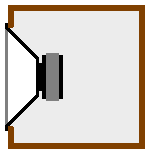
Acoustic suspension is a loudspeaker cabinet design that uses one or more loudspeaker drivers mounted in a sealed box. Acoustic suspension systems reduce bass distortion which can be caused by stiff suspensions required on drivers used for open cabinet designs.
A compact acoustic suspension loudspeaker was described in 1954 by Edgar Villchur,[1] and it was brought to commercial production by Villchur and Henry Kloss with the founding of Acoustic Research in Cambridge, Massachusetts.[2] In 1960, Villchur[3] reiterated that: The first aim of the acoustic suspension design, over and above uniformity of frequency response, compactness, and extension of response into the low-bass range, is to reduce significantly the level of bass distortion that had previously been tolerated in loudspeakers. This is accomplished by substituting an air-spring for a mechanical one. Subsequently, the theory of closed-box loudspeakers was extensively described by Richard H. Small.[4][5]
Speaker cabinets with acoustic suspension can provide well-controlled bass response, especially in comparison with an equivalently-sized speaker enclosure that has a bass reflex port or vent. The bass vent boosts low-frequency output, but with the tradeoff of introducing phase delay and accuracy problems in reproducing transient signals. Sealed boxes are generally less efficient than a bass-reflex cabinet for the same low-frequency cut-off and cabinet volume,[6] so a sealed-box speaker cabinet will need more electrical power to deliver the same amount of acoustic low-frequency bass output.
- ^ Cite error: The named reference
Villchur1954was invoked but never defined (see the help page). - ^ Cite error: The named reference
Schoenherr2008was invoked but never defined (see the help page). - ^ Cite error: The named reference
Villchur1960was invoked but never defined (see the help page). - ^ Cite error: The named reference
Small_CBPt1was invoked but never defined (see the help page). - ^ Cite error: The named reference
Small_CBPt2was invoked but never defined (see the help page). - ^ Cite error: The named reference
Small_VBPt2was invoked but never defined (see the help page).
© MMXXIII Rich X Search. We shall prevail. All rights reserved. Rich X Search
